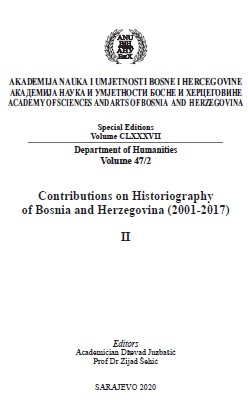Društveno-istorijski kontekst opstojnosti i razvoja države Bosne i Hercegovine u postdejtonskom vremenu
Sociohistorical context of the survival and development of the state of Bosnia and Herzegovina in Post-Dayton times
Author(s): Mirko Pejanović
Subject(s): Constitutional Law, Political history, Government/Political systems, Political behavior, Politics and law, Transformation Period (1990 - 2010), Present Times (2010 - today), Inter-Ethnic Relations, Socio-Economic Research
Published by: Akademija Nauka i Umjetnosti Bosne i Hercegovine
Keywords: Bosnia and Herzegovina; National Anti-Fascist Council of People's Liberation of Bosnia and Herzegovina; Parliamentary Assembly of Bosnia and Herzegovina; citizens' referendum; Dayton Peace Agreement;
Summary/Abstract: In the approach to constitutional reforms it is necessary to assure their gradual nature. In this context, in the framework of constitutional reform, the position of the institutions of the state of Bosnia and Herzegovina would be changed in the first phase, as proposed by the 2006 “April package” of amendments. This phase of constitutional reform can be implemented within the framework of negotiations on Bosnia and Herzegovina’s membership in the European Union, during the opening of the negotiation chapters. However, certainty of the process of constitutional change depends mostly on the geopolitical circumstances and geopolitical influence of the International Community, and in this context, especially the countries that are members of the Steering Board for the Peace Implementation Council responsible for the implementation of the Dayton Peace Agreement. A geopolitical framework established through the agreement of the world’s leading peace-building powers in Bosnia and Herzegovina on the basis of the Dayton Peace Agreement is necessary for change of the internal territorial organization, based on a two-entity structure. It is quite certain that a change in the internal territorial organization of Bosnia and Herzegovina will be possible at a time when Bosnia and Herzegovina finalizes the process of integration into Euro-Atlantic institutions. In its gradual nature, the second phase of constitutional change will encompass the change in the territorial internal organization of Bosnia and Herzegovina. This change will aim to abolish the ethnic territorialization derived from the two-entity model. The Republika Srpska entity is ethnically homogenized because 85% of the population is Serb. The Federation of Bosnia and Herzegovina is ethnically homogenized in five cantons with a majority of Bosniak people and three cantons with a majority of Croat people. This second phase of constitutional change will await for the time when Bosnia and Herzegovina is a member of the European Union and NATO. No more than three levels of government will then be able to be funded. Currently, the citizens of Bosnia and Herzegovina are financing: local government, cantonal government, entity and state government.
Book: Prilozi o historiografiji Bosne i Hercegovine (2001–2017) II
- Page Range: 211-229
- Page Count: 19
- Publication Year: 2020
- Language: Bosnian, Croatian, Serbian
- Content File-PDF

